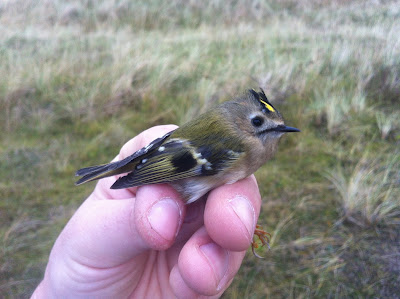Pied Flycatcher
Pied Flycatchers are generally passage migrants in Ireland, which breed sporadically, with 1 or 2 pairs some years. Possibly the last recorded breeding attempts were back in 2003 and 1999. The birds appear in small numbers around the Irish coast during autumn migration with Cape Clear being a reliable spot. The main concentrations are on the south coast, with Northern Ireland receiving one or two birds, every other year. This is also replicated in the ringing totals with only 5 having been ringed in the north since 1977, compared to 361 in the south.
Saltee Bird Observatory was a prolific spot for Pied Flycatchers in the early 60's with 53 ringed between 1960-62, with 23 caught in 1961. If I manage to source more data from the bird observatories pre 1977, I'm sure we will see quite a few more caught in this period.
Great Saltee (Saltee BO) was also a focal point for ringed birds coming into/passing Ireland with three of the five Irish recoveries since 1975 (one from 60's). The two birds from Wales and the bird from the Netherlands are birds ringed in the nest, that were caught on the coast of Ireland during subsequent spring migrations. The final two were caught during autumn with the bird from the Isle of May heading south and the bird from the Scilly Isles, heading in the wrong direction, four days after ringing.
Pied Flycatcher recoveries
Spotted Flycatcher
Spotted Flycatcher numbers have reduced greatly since the turn of the century in Ireland and this is replicated in the number ringed each year. The most productive year was 1990 with 212 birds ringed compared to 2007, when only 11 were caught. These numbers are probably artificially lowered with the inactive bird observatories on the south coast, with minimal ringing activities.
The stand out recovery was a bird ringed in Cashel, Co. Tipperary on 23/06/1984 and found dead 3.5 years later in Escola na Cidade de Kuimba, Angola. At the time this was only the third Spotted Flycatcher from the UK & Ireland to be recovered in Africa and the first for Angola. The recovery from mainland Europe refers to a bird born in Western Germany in June 1987, that decided to take a detour West on its first migration.
The Irish Sea bird observatories are important for the recoveries and also account for a large proportion of the birds ringed. Saltee Bird Observatory for example caught 274 Spotted Flycatchers between 1960-1963 with the best year of 90 birds ringed in 1960. For recoveries, Saltee BO has notched up at least seven recoveries (in & out), Bardsey BO - four and the Calf of Man BO - three.
Spotted Flycatcher Recoveries in Western Europe
Spotted Flycatcher recovery in Angola
Red-breasted Flycatcher
Red-breasted Flycatchers are irregular passage migrants in Ireland, with the majority hitting the south coast. A total of 22 have been ringed in Ireland since 1975, with none in Northern Ireland. At least a further 9 were ringed in the south going back to 1960 but this data was taken from limited records. Quite a few of these came from Saltee Bird Observatory, which seemed to be prolific for Flycatchers by Irish standards.
Numbers appear to have reduced in recent times but this may be down to the fact that there are no longer any bird observatories operating in the south.
The only control between 1975-2015 actually happened just last month, with a bird moving through Skokholm Bird Observatory on the 6th of October and appearing in a mist net near Loop Head, Co. Clare, eight days later. This was just the third recovery of a Red-breasted Flycatcher between Britain and another country.
Check out the Skokholm Blog for more details -
http://skokholm.blogspot.co.uk/2015/10/the-big-news-of-day-was-discovery-that.html?q=Red-breasted
Red-breasted Flycatcher recovery



























